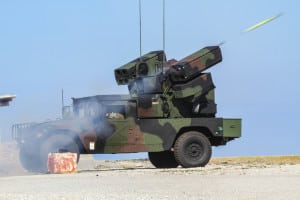The U.S. on Thursday approved a new $400 million weapons package for Ukraine, to include the first delivery of Avenger air defense systems.
The new security assistance deal, which is the 25th drawdown of equipment from Pentagon inventories, also includes providing missiles for Raytheon Technologies
’ [RTX] HAWK air defense systems that Spain is delivering to Ukraine.

“With Russia’s unrelenting and brutal air attacks on Ukrainian critical infrastructure, additional air defense capabilities are critical. The HAWK missiles, which will be refurbished using Ukraine Security Assistance Initiative funds, will complement Spain’s recent commitment of HAWK launchers to help Ukraine meet this threat. The Avenger short-range air defense systems will also provide Ukraine with capability to protect Ukrainian troops and critical infrastructure against unmanned aerial systems and helicopters,” the Pentagon wrote in a statement.
Last week, the U.S. announced a new Ukraine Security Assistance Initiative deal worth up to $400 million which included funds to refurbish HAWK air defense missiles that will be included in futures drawdown packages such as the one announced Thursday (Defense Daily, Nov. 4).
Deputy Pentagon Press Secretary Sabrina Singh was asked on Thursday if the department is concerned that supplying more Stinger missiles for use with the Boeing [BA]-built Avenger air defense systems would place further strain on Raytheon’s production line for the anti-aircraft weapon.
“The short answer to your question is no,” Singh said in response. “We wouldn’t have provided these Stinger missiles if we didn’t feel like we could.”
“In particular with the four Avenger air defense systems, these are mobile, short-range air defense systems that can protect against cruise missiles, helicopters, unmanned aerial systems. They’re shorter in range but some of the additional capabilities that we and Spain and others have provided, like the HAWK missiles, this something that I think will fit in well with some of the capabilities that they’re already using on the battlefield,” Singh added during the briefing.
Bill LaPlante, the Pentagon’s top acquisition official, said last Friday he believes Congress will approve a provision allowing the department to award multi-year contracts for munitions procurements, as the Pentagon looks to produce those weapons and refill its inventories following the U.S.’ move to supply Ukraine with large numbers of capabilities (Defense Daily, Nov. 7).
The new $400 million package announced on Friday also includes additional ammunition for HIMARS launchers, 21,000 155mm artillery rounds, 500 precision-guided 155mm artillery rounds, 10,000 120mm mortar rounds, 100 Humvees, 400 grenade launchers and small arms with more than 20 million rounds of associated ammunition.
Singh also said the Pentagon believes there will be continued support from lawmakers for continued security aid to Ukraine regardless of how the final midterm election results shape control of Congress.
“I think there is, in Congress on both sides of the aisle, a commitment to Ukraine that we’re in this for the long haul. So even with the midterms and the outcomes, I think Ukraine will still see security assistance and support from the United States in their fight,” Singh said.
Singh also responded to a question on how future weapons packages may potentially change when factoring in battlefield adjustments such as Russia’s moves to withdraw from Kherson.
“We are in touch with the Ukrainians frequently, regularly. We are assessing what they need on the battlefield. In the very beginning of this war, you heard us talking about Javelins and Stingers. Right now, we’re talking about HIMARS. We’re talking about…the HAWK missiles that need to be refurbished. We’re talking about different equipment as the battlefield changes and as we head into different environments and weather conditions as well,” Singh said.